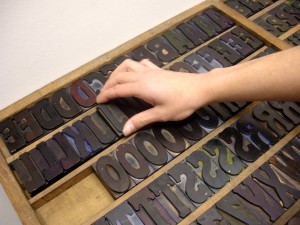
We used to have to manually set typeface in a printer. Now, we have the capability to print those same parts.
3D printers are popping up all over the place; Staples just announced that they will actually be carrying the Cube 3D printer in-store. It’s clear that this technology is the future, but with so many different definitions popping up, we have to wonder: exactly what is 3D printing?
Different Processes with the Same Goal
Defining regular printing is easy; it’s the process of putting ink on paper (or another material). The problem with defining 3D printing is that there are so many ways of doing it.
The first thing that comes to mind when people think of 3D printing is generally something like plastic jet printing. This method, which is used for the Cube printer, involves melting and layering material in a continuous stream, much like a hot glue gun. Another similar method is fused deposition modeling, which works a lot like a regular printer, but builds the material in three dimensions.
You can also print using the laminated object manufacturing method, which uses lasers to cut and stack layers of material. This isn’t technically “printing” the way most people think of it, but it is still a great way to make three dimensional objects fairly easily. On the other end of the spectrum is selective laser sintering, which draws the object in a box of raw, powdered material. Because this process allows for stable structures, it can be used to create anything from a simple prototype to part of a car or a plane.
Additive and Computer Driven
These processes are all incredibly different, but they have two common factors: they are additive, and they are computer driven.
The first printing presses were definitely not computer driven; the blocks and templates had to be lined up by hand, inked with a brush, and then pressed onto a piece of paper. But with 3D printing, computers are a vital aspect. Otherwise, creating a three dimensional object would be considered sculpting, or crafting in a different manner.
All 3d printers also work by an additive process. They take one material, and add it to either another material, or to air. Even laminated object manufacturing, which cuts pieces of material, still stacks them to form each part.
So What is 3D Printing?
With a rough idea of the different kinds of 3D printing in mind, let’s take a look at the popular definition for the process. According to PC Mag, 3D printing is
“The making of parts and products using a computer-driven, additive process, one layer at a time.”
Notice that this definition doesn’t say “plastic parts”, or require any specific form of technology. Because there are so many different kinds of 3D printing, adding either of these elements to a definition would make it far too narrow. 3D printers can be used to make all sorts of objects, from all kinds of materials.
So what is 3D printing? It’s anything that will, through an additive, computer-driven process, make something new.
